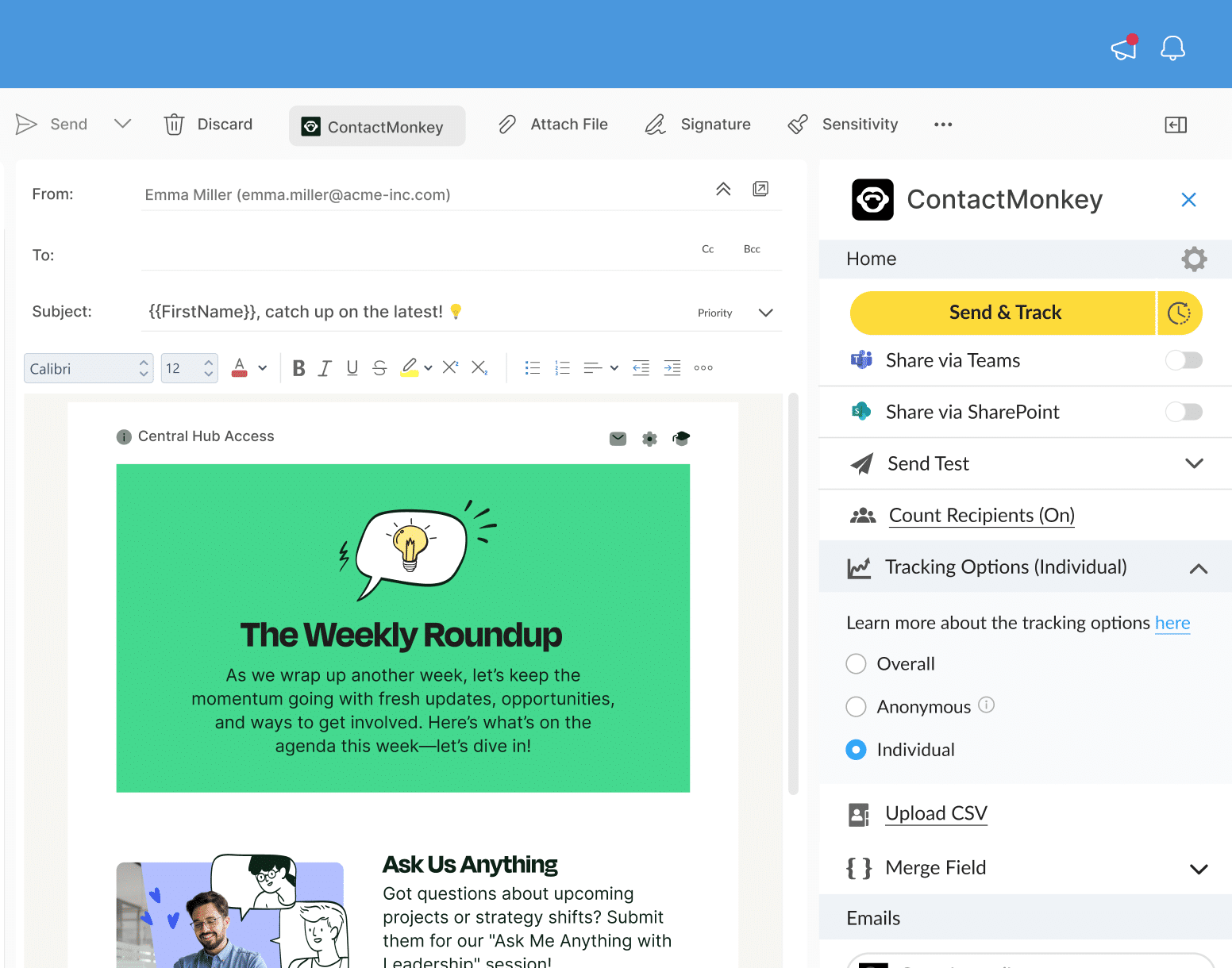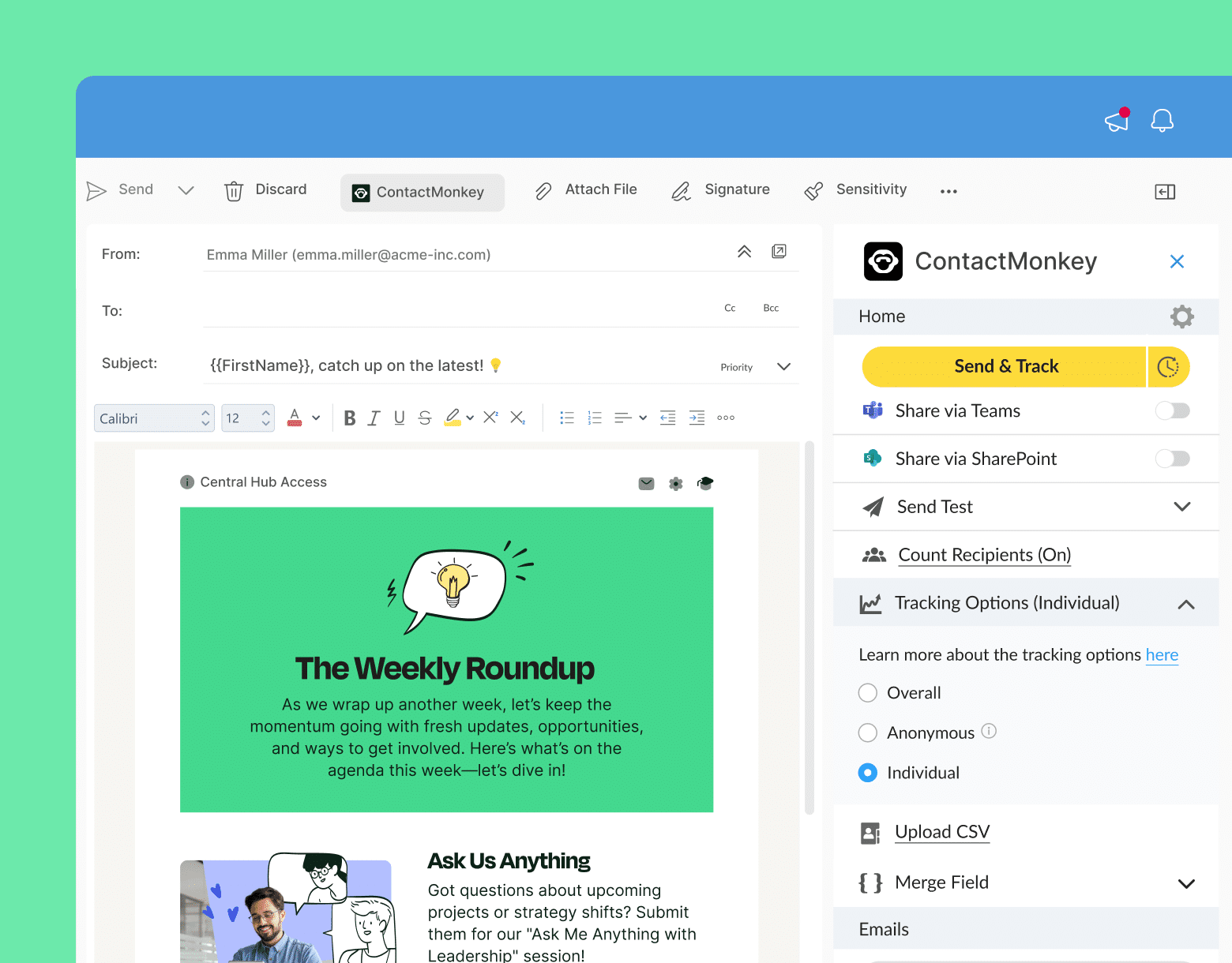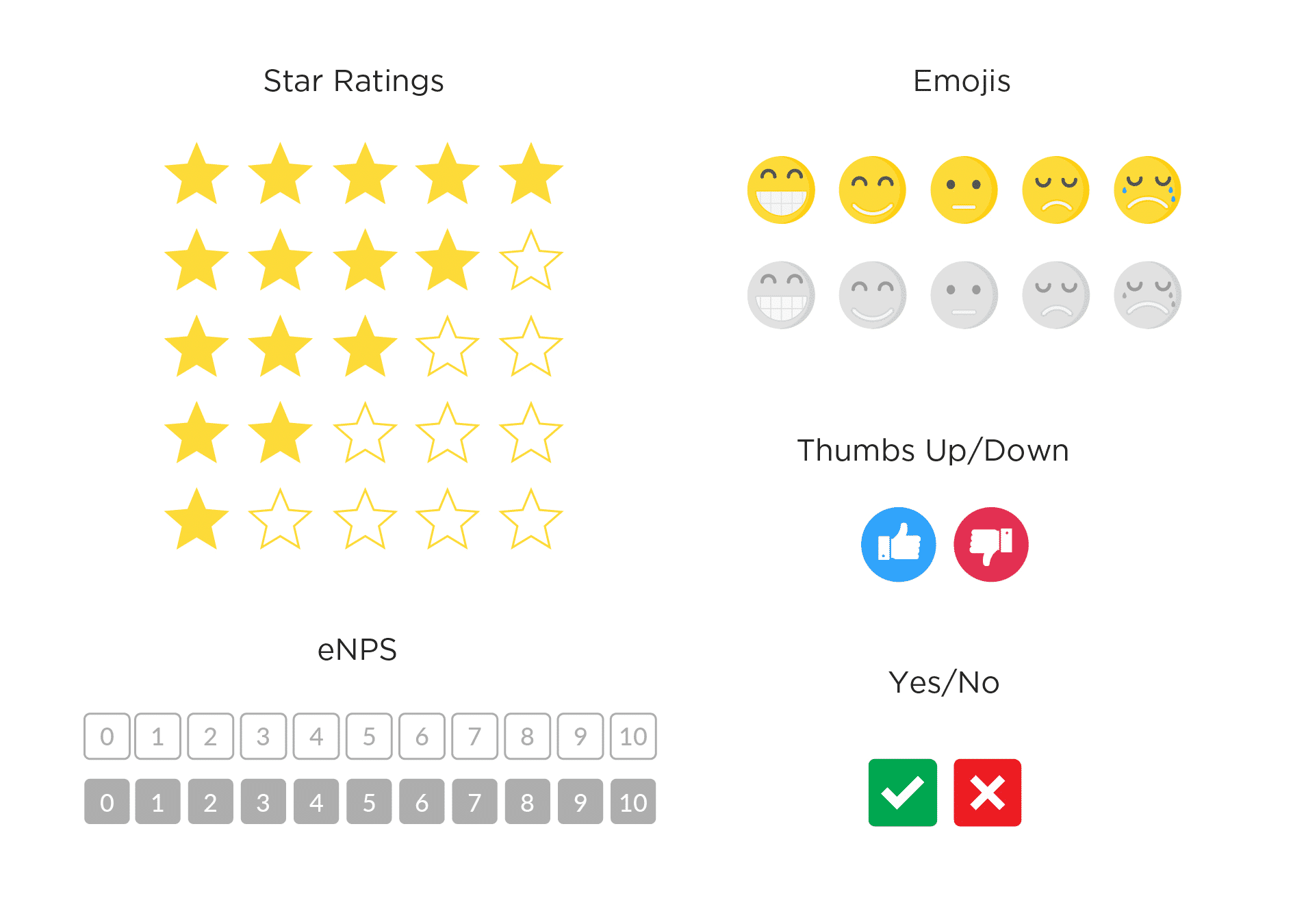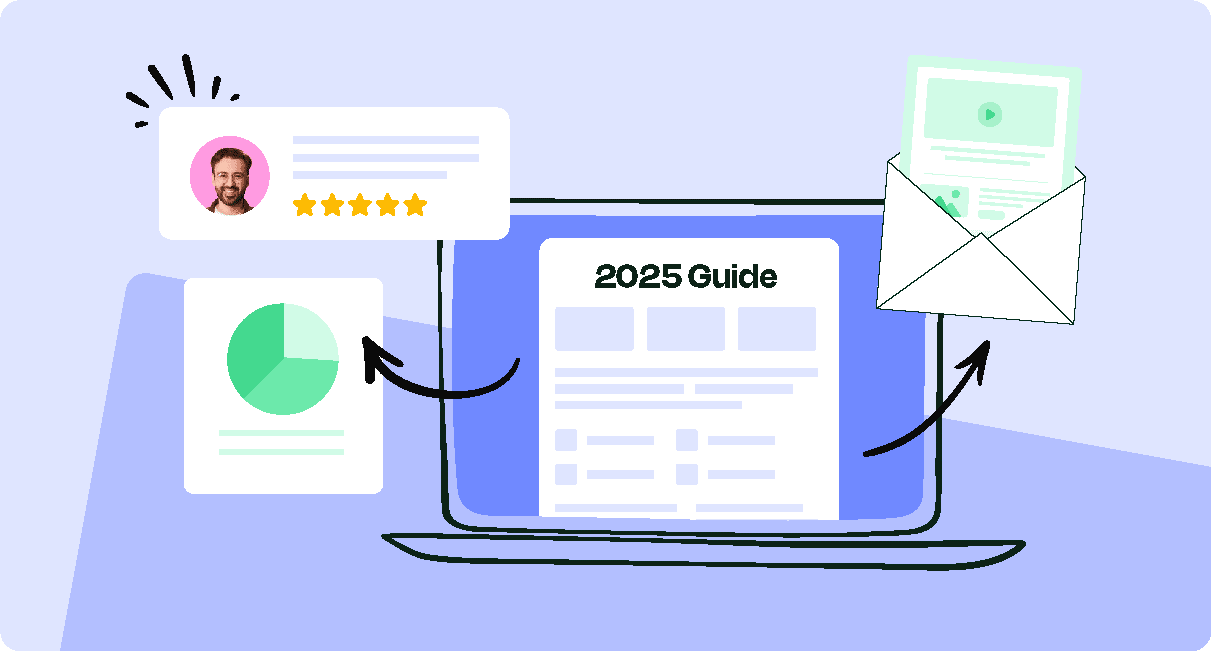With effective internal marketing, your employees become brand ambassadors. But what does it really take to implement a successful internal marketing strategy? We’ve compiled everything you need to know about internal marketing so you can start leveraging its benefits.
When you think of the word ‘marketing,’ chances are you imagine pitching and selling to customers. Rarely do we consider marketing in the context of promoting a company to its own employees. And yet, internal marketing is just as valuable as external marketing.
In fact, the two go hand-in-hand. The main objective of internal marketing is to engage, inform, and inspire employees so that they can excel in their roles.
By fostering employee engagement and effective communication, internal marketing can help you empower your teams and improve business outcomes simultaneously.
We’ll take a deep dive into everything you need to know about effective internal marketing and why you should use an internal email tool and not an external tool like Mailchimp for internal communications.
Take a self-guided tour of ContactMonkey
See how our key features can streamline your internal communications.
Take product tour

What is Internal Marketing?
Internal marketing is when you sell the brand from the inside. Similarly to external marketing, the goal is to promote company products, services, and brand values.
External vs Internal Marketing
The difference between external and internal marketing is the target audience. For internal marketing, the target audience is made up of employees rather than customers.
However, you still want to apply external marketing techniques to an internal approach. That means creating an internal marketing plan, deciding who will oversee your internal marketing strategy, and understanding the difference between internal vs external communication tools.
In the long run, the intended outcome of internal marketing is to enhance employee engagement and boost business performance. In the case of email marketing for universities, the goal is to align faculty, staff, and students and ensure everyone is on the same page.
Internal marketing doesn’t have to be a painstaking process. With great internal communications tools like ContactMonkey, you can streamline the key components of your internal marketing strategy through a single platform — your employee newsletter.
Why is Internal Marketing Important?
Internal marketing is important because it helps align employees with brand goals and values.
When employees understand and endorse their company’s mission and principles, they’re better equipped to promote the brand to customers. After all, internal communications directly impacts customer experience.
More importantly, employees feel and do better at their jobs because they’re truly motivated by their organization’s goals.
Modern internal comms and measurement tools
No design or technical expertise needed. Save time, increase engagement, and dazzle your employees with fun and interactive communications.
Explore all features

Benefits of An Internal Marketing Program
Still not convinced that you need an internal marketing strategy for your business? Here are some key benefits of an internal marketing program that you should consider.
Increased employee engagement
Engaged employees are not only more satisfied in their jobs, but 17% more productive. This makes employee engagement one of the biggest benefits of an internal marketing strategy.
Effective internal marketing inspires employee engagement through a clear and compelling vision of the company’s mission. Whether it’s through effective communications or inspiring internal storytelling, employees gain a deeper sense of purpose at the company.
When employees understand and feel inspired by organizational goals, they’re more likely to excel in their roles. They also believe in the product they’re promoting to customers, which improves both employee experience and customer satisfaction.
Higher employee retention
When employees feel inspired and invested in their role, they’re less likely to be swayed by recruiters.
With effective internal marketing, employees are continuously reminded about the benefits of working at their company.
They’re informed about opportunities for professional growth and are motivated to grow within the organization. Once employees have a sense of pride in what they do alongside a vision for growth, they will stay at your company longer and perform better.
Strengthened company culture
An effective internal marketing strategy provides employees with a cohesive set of messages, visuals, and practices that represent the internal brand. This is the basis for a strong company culture.
A great example of this idea in action can be seen at Southwest Airlines. The company’s signature heart logo became a key part of its successful internal marketing strategy.
The heart was a visual emblem as well as a symbol for the practices and values prioritized by Southwest employees. It extended across their external and internal brand through mottos like “showing heart” and the company’s internal brand pillars, “a warrior spirit, a servant’s heart, fun-loving attitude.”
With effective internal marketing, employees begin to engage with common values and practices. This leads to a sense of pride in the brand identity and a strong company culture.
Enhanced customer service/satisfaction
Customers are a lot more likely to trust a product recommendation from a friend or family member. With effective internal marketing, your employees develop a strong connection with your products and are more inclined to recommend them to their close circle.
But it also goes beyond that. With great internal marketing, customer service improves as a whole. That’s because your staff start to truly believe in the product and are enthusiastic about their role in providing it. And your clients pick up on this fast.
To harness this asset, make sure you’re telling a great brand origin story. This will give employees a better understanding of the ‘why’ behind your brand and get them excited to be a part of it.
Watch ContactMonkey LIVE in action
Join live demo

Internal Marketing Examples
Internal marketing can take on many forms. Here are just a few of the most common examples of internal marketing and company newsletter ideas:
- Employee appreciation day
- Job promotion opportunities
- Internal contests and rewards
- Employer branding initiatives
- Employee social media and shoutouts using Slack
- Employee performance reviews and internal spotlights
- Competitive compensation and benefits with perks like free lunch
- Company news and milestone highlights in your company newsletter
- Work-life balance initiatives such as unlimited vacation or extra days off during summer
- Professional development opportunities, including free webinars or course subscriptions
- Promotional internal communications campaigns, such as “Associate of the Month” profiles
10 Components of a Successful Internal Marketing Strategy
Now that we’ve covered why an internal marketing strategy matters, let’s dive into how it actually works. We’ll break down the key components of a successful internal marketing strategy and give you actionable ways to harness it in your business.
1. Set internal marketing goals and objectives
Setting internal marketing objectives is the first step to launching a successful internal marketing strategy.
Your internal marketing goals can include increasing awareness around professional development opportunities or raising employee engagement.
Whatever your objectives are, they should be backed by internal marketing metrics. These can include improvements in customer feedback or a rise in positive responses to engagement surveys sent through your employee feedback platform.
2. Scope
Establishing the scope of your internal marketing strategy means determining the scale of your desired outcomes. Are you trying to strengthen your existing internal brand or transform it all together?
If you’re trying to enhance what you already have in place, think about adding brand stories or employee testimonies into your employee newsletter.
For a company-wide transformation, you’ll need to think bigger. Consider making presentations about your new brand products and team goals or building new visuals for your internal company newsletter.


3. Designated internal marketing team
Once you have the rough outline of your internal marketing plan, you’ll need to decide who will be responsible for guiding your internal marketing program.
While many companies choose HR teams or dedicated internal communications teams for this task, it’s important to involve many teams and departments for more diverse perspectives.
Employees from all levels and roles should be involved in building your internal marketing strategy. Zappos is a great example of a company that puts this approach to action.
Through “employee-generated media”, Zappos involves all levels of employees in their internal and external marketing.Staff is encouraged to build the brand inside-out through posts, comments and conversation on Twitter and internal blogs.
4. Effective Internal Communications
Your internal communications are at the heart of your internal marketing strategy. From employee newsletters to leadership communications, internal emails present your brand mission, educate employees on company values and goals, and encourage employee feedback.
Your internal communications set the tone of your employer brand and give employees different cues about your company. Not to mention, internal communications also work as a toolkit. They give employees resources and equipment in the form of company eBooks, employee forums, newsletter updates, and the like.
All of these add up to a store of knowledge about your company and form the base of your internal marketing efforts.
5. Clear brand vision
A core component of effective internal marketing is communicating a vision that’s worth pursuing. Employees want a clear understanding of your brand’s value proposition and their role in it.
Starbucks is a good example of a company with a compelling vision and a clear vision statement: “To inspire and nurture the human spirit – one person, one cup and one neighborhood at a time.”
Starbucks’s mantra is communicated both to customers and employees, who the company calls “partners.” This small gesture equally conveys one of the brand’s biggest values – collaboration and community.
6. Fluid dialogue between employees
Agreat vision also needs to be supported with employee feedback and dialogue. For effective internal marketing, your employees have to be able to join in a conversation about your brand, share ideas, and provide feedback.
Employee newsletters are great tools for boosting employee dialogue and driving your internal marketing strategy.
Newsletters create two-way conversation through idea-sharing, embedded surveys and commenting options. This boosts engagement and makes employees feel that their opinion is valued, which is essential for successful internal marketing.
Get powerful send features with ContactMonkey
Create custom audiences, increase content relevancy, and improve employee email engagement.
Learn more

7. On-brand messaging
Regardless of what types of internal communications channels you choose, you need to make sure your messaging is always on-brand and consistent. That means aligning your internal brand voice across all of your internal communications channels and matching it to your external brand.
With consistent and on-brand internal communications as a priority in your internal marketing strategy, your employees will have a clear image of your brand. And they’ll convey it just as well to customers.
For more ideas on effective internal communications, listen, and learn from dozens of IC experts at this year’s top internal communications conferences.
8. Internal marketing benchmarks
With clearly defined benchmarks, you’ll be able to easily see whether your internal marketing strategy is achieving the desired outcomes.
Your performance benchmarks can include objectives like getting a high employee satisfaction score on your recent employee survey or a soaring eNPS score.
eNPS (Employee Net Promoter Score) determines the likelihood that your employees would recommend your business to others. It’s measured using a simple scale rating question such as the one below:
9. Internal marketing audit
Measuring the performance of your internal marketing strategy is essential to its success. An internal marketing audit looks at the analytics behind employee emails and newsletters to see the impact of your efforts.
With an email tracking tool like ContactMonkey, you can check how many of your employees are reading key company announcements, learning about product updates or checking career development resources.
If your organization has internal or external regulations around email privacy, ContactMonkey’s anonymous email tracking allows you to gather email metrics while maintaining your employees’ privacy.
10. Consistent feedback
To make sure you’re getting continuous feedback on your internal marketing efforts, you’ll also need to gather feedback using a pulse survey tool.
These short, simple surveys are designed to take a ‘pulse check’ of your workplace through a single focused question on your topic of choice.
With ContactMonkey, you can embed short, simple pulse surveys into your employee newsletter. From there, you’ll be able to gather employee insights on topics related to your internal marketing goals.
Build engaging, interactive employee emails in minutes
Build amazing emails quickly and easily using our drag-and-drop template builder. No design or technical expertise needed.
Explore email builder

5 Best Internal Marketing Tools
At this point, you’re probably thinking that an effective internal marketing strategy is no walk in the park. From setting your internal marketing goals to gathering continuous employee feedback, there are many pieces you have to connect.
Luckily, there are some great tools to help you implement your internal marketing strategy and get the benefits without working overtime. Here are our favourites:
1. Internal Email
Your employees want a consistent source for their daily scoop. With an internal emailnewsletter, employees get key company insights while learning about new internal marketing campaigns, events and everything in between. And that covers the to-do items in your internal marketing checklist.
Company newsletters synchronize every other channel of internal communications. You can include videos communications, podcasts, and company PR to create a unified brand image.
And that’s not all. Your internal newsletter can also be a treasure trove of employee feedback.
With an interactive email tool like ContactMonkey, you can include surveys and anonymous commenting options to get feedback and build conversations. The best part? You can do it all through your Outlook or Gmail.
You can also use ContactMonkey’s List Management feature to build custom email lists to increase the effectiveness of your internal emails. Your custom email lists can be created without IT, and integrate with your Human Resource Information System (HRIS) like Workday and ADP, as well as Azure active directory, so they update automatically.
2. Employee Surveys
With the right questions, employers can understand how their staff perceive their products, brand mission and values. They can also check whether an existing internal marketing strategy really resonates with their staff.
If you notice misalignment between your desired brand image and how your employees see things, it’s your job to mend the gap.
Employee surveys let managers understand their staff’s level of satisfaction, engagement and connection with the brand and its products.
With ContactMonkey’s employee pulse surveys, you can get feedback in a style and speed that’s best suited to your goals. Options include eNPS surveys, emoji reactions, star ratings, and Like buttons.

Not sure what questions to include in your internal communications? Try using ContactMonkey’s OpenAI ChatGPT integration to generate unique questions based on prompt you provide. Simply edit the output text so it applies directly to your audience.
3. Videos
You already know the power of video when it comes to external marketing. Just try thinking of brands like OldSpice or Nike without being reminded of their iconically ridiculous ads or extravagant celebrity promos.
When it comes to internal marketing, videos are just as powerful.
Videos provide much more creative opportunities than text alone. They allow you to create powerful messages and dynamic brand storytelling through sound, animation and tonality.
The result is a stronger emotional response from the audience, which is crucial for conveying authenticity.
What’s more is that your employees are about 1200% more likely to share videos than just text and graphics alone. This is especially true when it comes to Gen-Z audiences. This means that by using video, you’ll be able to multiply the reach of your internal marketing strategy.
We recommend using a video-making tool tailored to corporate content like Clipchamp. With its intuitive drag-and-drop video editor, Clipchamp makes it easy to create professional corporate videos. When your video is ready, embed it into your employee newsletter with a video-friendly internal communications tool like ContactMonkey.
Want to take your videos to a whole new level? Learn about using virtual reality in corporate communications.
Take a self-guided tour of ContactMonkey
See how our key features can streamline your internal communications.
Take product tour

4. Video Conferencing
Old fashioned video conferencing software shouldn’t be underestimated in your internal marketing strategy.
With remote work becoming more common, video conferencing can be a powerful tool to drive awareness about products and forge a strong company culture.
By allowing face-to-face interaction and collaboration, video conferencing tools like Zoom and Microsoft Teams provide more opportunities for team-building and bonding.
When using video conferencing, take advantage of screen sharing for collaborating on a project or sharing team performance data. By showcasing team progress and achievements, you’ll get your teams working towards a common goal, and building trust.
5. Intranet Software
Think of an intranet as a jack of all trades. It gives staff access to news, company resources, internal training modules, employee chats and a whole lot more. Because of its multifunctional abilities, an intranet has some pretty big perks for internal marketing.
Intranets connect employees from different teams and levels on a single platform where they can have conversations, share ideas and learn from each other.
They also showcase your company’s internal brand voice, brand image, and company culture in a unified way. This gives employees a clear idea of what the brand’s all about.
Jostle is a great example of an effective intranet platform. Its cloud-based software provides clear information architecture that helps streamline communication in the workplace.
To get the most out of your Intranet, use it alongside your employee newsletter. You’ll drive more traffic to your Intranet by reminding employees to checkfor updates and linking them to Intranet features and posted events.
6. Employee SMS
SMS strengthens and extends the reach of your internal communications while ensuring that remote, deskless and frontline workers stay engaged.
With over 90% of texts being opened within five minutes, SMS is a quicker, more reliable way for relating time-sensitive information. This includes emergency alerts, meeting reminders, and schedule changes. But it also lets you promote employee events, remind staff about engagement surveys, and draw attention to other internal marketing campaigns.
With ContactMonkey’s SMS text builder, internal communicators can embed links, event invites, and reminders straight into employee texts. This makes it easier for staff to access key resources right from their messaging app—whether they’re on the go or at the office.
How to Improve Your Internal Marketing Program With ContactMonkey
With ContactMonkey, you can centralize your internal marketing strategy through a single tool. That’s because ContactMonkey combines employee emails, surveys and email tracking all in one place.
Through the email template builder, you can easily keep employees informed and engaged by embedding graphics, videos, and surveys into your weekly newsletter. You’re also able to ask questions and let employees voice concerns through a variety of employee feedback options and anonymous comments.
Once you send out your employee emails, simply track and measure engagement through Contact Monkey’s Reporting tool. The result: a simpler way to implement your internal communications strategy and get employees informed and excited about your brand.
Key Takeaways
If your brand doesn’t have buy-in from your employees, you won’t be able to captivate customers. When staff are engaged, excited and informed about your products, they convey that same enthusiasm to clients.
With effective internal marketing, your employees will start feeling more connected to your brand and understand its mission, vision, values, and goals. They’ll become brand ambassadors and earn the trust of your clients through their own confidence in the product.
Learn how to use an internal communications software to implement an internal marketing strategy that’s tailored to your goals. ContactMonkey makes it easier to collect employee feedback and inspire staff.Get started with your free trial today!



